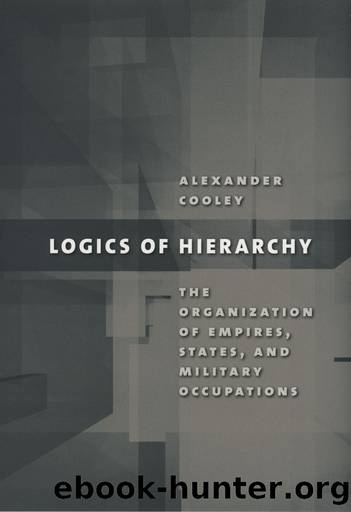Logics of Hierarchy: The Organization of Empires, States, and Military Occupations by Alexander Cooley

Author:Alexander Cooley [Cooley, Alexander]
Language: eng
Format: epub
Tags: History & Theory, Political Science, World, Asian, Russian & Former Soviet Union
ISBN: 9780801443862
Google: rfytDwAAQBAJ
Goodreads: 256726
Publisher: Cornell University Press
Published: 2005-11-15T00:00:00+00:00
* * *
1. For an important exception that does examine variations in patterns of state-building and identity formation, see David Laitin, Identity in Formation: The Russian-Speaking Populations in the Near Abroad (Ithaca: Cornell University Press, 1998).
2. For a fascinating debate on the role of transitology in post-Soviet studies, see Terry Lynn Karl and Philippe Schmitter, âThe Conceptual Travels of Transitologists: How Far to the East Should They Attempt to Go?â Slavic Review 53 (1994): 173â85; and Valerie Bunce, âShould Transitologists Be Grounded?â Slavic Review 54 (1995): inâ27.
3. Oksana Olga Dmitrieva, Regional Development: The USSR and After (London: UCL Press, 1996), ix.
4. Some recent contributions have already demonstrated the theoretical fruitfulness of applying economic concepts of organization to the study of Soviet hierarchies. See Steven Solnick, Stealing the State: Control and Collapse in Soviet Institutions (Cambridge: Harvard University Press, 1998); and Randall Stone, Satellites and Commissars: Strategy and Conflict in the Politics of Soviet-bloc Trade (Princeton: Princeton University Press, 1996).
5. Alexander Motyl, Imperial Ends: The Decay, Collapse, and Revival of Empires (New York: Columbia University Press, 2001); Karen Dawisha and Bruce Parrott, eds., The End of Empire? The Disintegration of the USSR in Comparative Perspective (Armonk, N.Y.: M. E. Sharpe, 1996); Karen Barkey and Mark von Hagen, eds., Afer Empire. Multiethnic Societies and Nation-Building: The Soviet Union and the Russian, Ottoman, and Habsburg Empires (Boulder, Colo.: Westview Press, 1997); and Hendrik Spruyt, Ending Empire (Ithaca: Cornell University Press, ZO05).
6. Martha B. Olcott, âThe Basmachi or Freemenâs Revolt in Turkestan 1918â24,â Soviet Studies 33 (1981): 352â69.
7. On the political aims of Soviet nationalities policy, see Mark Beissinger, Nationalist Mobilization and the Collapse of the Soviet State (New York: Cambridge University Press, 2002); Laitin, Identity in Formation; and Philip Roeder, âSoviet Federalism and Ethnic Mobilization,â World Politics 43 (1991): 196â232.
8. On Soviet strategies and Central Asian administration, see Pauline Jones Luong, Institutional Change and Political Continuity in Post-Soviet Central Asia: Power, Perceptions, and Pacts (New York: Cambridge University Press, 2002), especially chap. 2. Also see Steven L. Burg, âMuslim Cadres and Soviet Political Development: Reflections from a Comparative Perspective,â World Politics 37 (1984): 24â47; and Geoffrey Wheeler, The Modern History of Soviet Central Asia (Westport, Conn.: Greenwood Press, 1974).
9. For representative works in this debate, see William Fierman, Soviet Central Asia: The Failed Transformation (Boulder, Colo.: Westview Press, 1991); and Nazif Shahrani, âMuslim Central Asia: Soviet Developmental Legacies and Future Challenges,â in Central Asia and the Caucasus afer the Soviet Union, ed. Mohiaddin Mesbahi, 56â71 (Gainesville: University of Florida Press, 1993).
10. As quoted in Ellen Jones and Robert Grupp, âModernisation and Ethnic Equalisation in the USSR,â Soviet Studies 36 (1984), 159, ft. 3.
11. On Soviet nationalities policy, see Laitin, Identity in Formation; Rogers Brubaker, Nationalism Reframed (New York: Cambridge University Press, 1996); and Alexander J. Motyl, Sovietology, Rationality, Nationality: Coming to Grips with Nationalism in the USSR (New York: Columbia University Press, 1990).
12. World Bank, Statistical Handbook: States of the Former USSR, 1992 (Washington, D.C: World Bank, 1992).
13. On the organization of these
Download
This site does not store any files on its server. We only index and link to content provided by other sites. Please contact the content providers to delete copyright contents if any and email us, we'll remove relevant links or contents immediately.
Hit Refresh by Satya Nadella(9077)
The Compound Effect by Darren Hardy(8869)
Change Your Questions, Change Your Life by Marilee Adams(7678)
Nudge - Improving Decisions about Health, Wealth, and Happiness by Thaler Sunstein(7655)
The Black Swan by Nassim Nicholas Taleb(7054)
Deep Work by Cal Newport(6961)
Rich Dad Poor Dad by Robert T. Kiyosaki(6506)
Daring Greatly by Brene Brown(6472)
Principles: Life and Work by Ray Dalio(6296)
Playing to Win_ How Strategy Really Works by A.G. Lafley & Roger L. Martin(6076)
Man-made Catastrophes and Risk Information Concealment by Dmitry Chernov & Didier Sornette(5951)
Digital Minimalism by Cal Newport;(5700)
Big Magic: Creative Living Beyond Fear by Elizabeth Gilbert(5675)
The Myth of the Strong Leader by Archie Brown(5456)
The Slight Edge by Jeff Olson(5376)
Discipline Equals Freedom by Jocko Willink(5333)
The Motivation Myth by Jeff Haden(5174)
The Laws of Human Nature by Robert Greene(5073)
Stone's Rules by Roger Stone(5051)
